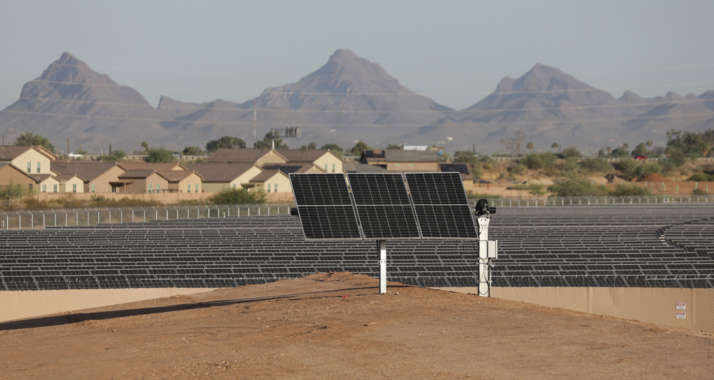
For Immediate Release: July 8, 2019
Tucson, Ariz. – Tucson Electric Power (TEP) is engaging key community stakeholders, collaborating with world-class climate experts at the University of Arizona, and proposing development of new carbon emission reduction goals to prepare for its customers’ future energy needs.
TEP’s 2019 Preliminary Integrated Resource Plan (PIRP), filed last week with the Arizona Corporation Commission (ACC), outlines strategies the company will use to build an energy portfolio that supports reliable, affordable and increasingly sustainable service over the next 15 years.
“Although TEP is on track to surpass its ambitious renewable energy goal of doubling the state requirement by expanding the use of wind and solar, we’re no longer satisfied with simply counting green kilowatts to gauge our progress toward greater sustainability,” said David G. Hutchens, TEP President and CEO. “Our commitment to improving the quality of life in our community, both now and well into the future, has motivated us to develop new, more comprehensive goals that will be focused on reducing greenhouse gases as quickly as possible while maintaining affordable and reliable service for our customers.”
TEP’s new carbon emission reduction goals will be informed by the global temperature level limits outlined in the 2015 Paris Agreement on climate change. For this effort, TEP has solicited support from climate experts at the University of Arizona’s Institute of the Environment to develop measurable, science-based targets.
The institute’s experts in climate science and the regional impacts of global temperature change will provide scientific knowledge and context necessary for TEP to develop appropriate emission reduction goals in its final 2020 IRP.
“We’re pleased to be working with TEP to look for opportunities to cut greenhouse gas emissions. The idea is to help TEP set a goal that is scientifically based,” said project leader Andrea K. Gerlak, an associate professor with the School of Geography & Development in the UA’s College of Social & Behavioral Sciences. “Our process will consider how climate change is impacting our community and how we can set a goal that is sensitive to our community and reflects the best available science. It’s very much a collaborative process.”
TEP will use input from researchers with the Institute of the Environment to evaluate cost-effective resource portfolio designs that would maximize carbon emission reductions while maintaining affordable and reliable service for customers.
A key aspect of developing more meaningful resource planning goals involves the formation of a new community stakeholder advisory committee. Through the end of 2019, TEP will meet monthly with a knowledgeable, diverse group of customers, community leaders and advocacy groups to hold in-depth discussions about key resource planning considerations.
“Input from our advisory committee and members of the public will be crucial in developing long-term resource plans to meet the energy needs of our community as we work toward building a cleaner, more flexible electric system,” Hutchens said.
Advisory committee members include representatives from the UA’s Institute of the Environment, Sierra Club, Residential Utility Consumer Office (RUCO), Southwest Energy Efficiency Project, Davis-Monthan Air Force Base, Pima Council on Aging, local governments and Wildfire, which advocates for limited-income residents. Members represent several customer classes, including residential customers and seniors, as well as small, medium and large commercial customers. TEP also will incorporate comments received through public workshops hosted by the ACC and the company.
Kevin Koch, an advisory committee member and an owner of Technicians For Sustainability, a local rooftop solar installer, said he supports moving toward an electric grid powered solely by renewable energy. Koch said he is learning more about the challenges and opportunities involved in building a more renewable-focused electric system.
“I am honored and excited to be part of the TEP IRP planning process,” Koch said. “The diversity of interests and perspectives in the group has helped to color in the picture of generation assets and energy forecasting covered in the first two meetings, and underscores the complexity of planning in a process with so many different stakeholders.”
In the preliminary plan, which is available at tep.com/resource-planning, TEP also describes:
- Support for a single, coordinated resource planning process before the ACC. Currently, renewable energy standards, energy efficiency standards and other resource planning topics are reviewed in separate dockets. TEP recognizes that customers’ energy needs and choices continue to evolve, while emerging technologies offer new options for electric service providers. An integrated proceeding would allow TEP to more thoroughly and efficiently evaluate resource options.
- Significant progress toward achieving its goal to generate 30 percent of its power from renewable resources by 2030, twice the state-mandated requirement of 15 percent by 2025. TEP plans to place 446 MW of new wind and solar projects into service by the end of 2020. The company expects that production from TEP’s renewable energy resources will exceed 28 percent of its retail sales in 2021.
- Continuing efforts to diversify its existing resources. TEP is expanding the use of cleaner, cost-effective natural gas resources while decommissioning several coal-fired resources. Over the last several years, TEP recognized the need to reduce its reliance on baseload coal resources. By 2022, TEP will have retired more than 600 megawatts of coal fired generation. These retirements represent a 41 percent decrease in TEP’s coal capacity since 2014.
TEP provides safe, reliable electric service to approximately 425,000 customers in Southern Arizona. For more information, visit tep.com. TEP and its parent company, UNS Energy, are subsidiaries of Fortis Inc., which owns utilities that serve more than 3 million customers across Canada and in the United States and the Caribbean. For more information, visit fortisinc.com.
News Media Contact:
Joseph Barrios
(520) 884-3725
jbarrios@tep.com






